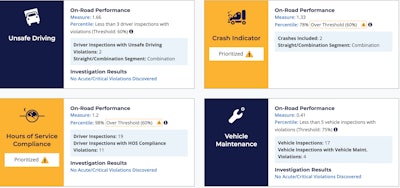 FMCSA has launched a preview site that allows carriers to log in and see their carrier profile with the proposed SMS changes. A portion of the updated scores for an example carrier are shown here.FMCSA
FMCSA has launched a preview site that allows carriers to log in and see their carrier profile with the proposed SMS changes. A portion of the updated scores for an example carrier are shown here.FMCSA
FMCSA released a report in 2018 that laid out how the agency planned to proceed in reforming its Compliance, Safety, Accountability program, including a revamp of the SMS.
In its report, NAS agreed that FMCSA’s approach to measuring carrier safety, based on crash prevention rather than prediction, is sound, the agency asserted, though the notice to be published Wednesday makes clear that NAS, as previously reported, urged a variety of improvements to the overall CSA SMS approach. FMCSA's notice focuses on one of six NAS recommendations to FMCSA regarding improvements to the SMS, which was to develop a so-called Item Response Theory (IRT) model to more accurately target at-risk carriers for intervention.
Yet FMCSA is not adopting such a model, as the agency lays out in the notice, rather changes to various aspects of the current SMS that FMCSA Administrator Robin Hutcheson believes will enhance "the fairness, accuracy, and clarity of our prioritization system,” she said.
[Related: Devil's in the data: FMCSA seeks sources, improvements for CSA revamp in public meeting]
New CSA SMS category structure
When testing an IRT model, FMCSA found “many limitations and practical challenges,” concluding that IRT modeling doesn’t perform well in identifying carriers for safety interventions. Instead, the agency found during the IRT modeling study that certain areas of the SMS “could be improved to better identify high risk carriers for intervention, without the complications inherent in adopting an IRT model.”
As part of those changes, FMCSA proposes to reorganize the current Behavior Analysis and Safety Improvement Categories (BASICs), which will be renamed “safety categories,” to better identify specific problems. To achieve this, FMCSA proposes to combine the current 959 violations used in SMS, plus 14 additional violations not currently used in SMS, into 116 new violation groups.
FMCSA is moving the Controlled Substances/Alcohol and Operating while Out-of-Service (OOS) violations into the Unsafe Driving category to “help focus FMCSA’s investigative resources on carriers with higher crash rates,” FMCSA said. The agency is also splitting the Vehicle Maintenance category in two -- Vehicle Maintenance: Driver Observed and Vehicle Maintenance. The new "Driver Observed" category will be reserved for roadside-observed “violations that could reasonably be observed by a driver” during a pre- or post-trip inspection, “or detected as part of a Walk-Around (Level 2) roadside inspection.”
[Related: FMCSA makes strides in targeting highest-risk carriers, report concludes, but challenges remain]
Reorganizing the Vehicle Maintenance categories, FMCSA believed, will “provide more specific information to help motor carriers and enforcement pinpoint unsafe driver behavior and sources of vehicle maintenance issues.”
Preview violation severity weight, category intervention threshold changes
Additionally, proposed changes include a dramatic simplification of violation severity weights, currently assessed on a 1-10 scale (with 10 the most safety-negative); changes designed to eliminate percentile-ranking jumps that occur when carriers move into a new safety event group, a well-known issue for small carriers; and adjusting safety categories' intervention threshold, the percentile ranking at which a carrier is prioritized for investigation or other follow-on agency/state action.
Currently, FMCSA uses a 1-10 weighting scale for violations in the SMS that are intended to reflect the violation's relationship to crash occurrence and/or crash consequences. Under the new proposed SMS, all violations will receive just one of two severity weights -- namely, 1 or 2. Out-of-service violations for any safety category except Unsafe Driving will receive a 2, as will driver-disqualifying violations in the Unsafe Driving category.
For intervention thresholds, current SMS methodology prioritizes carriers for investigations if their percentile rankings are at or above certain those thresholds. With the updated prioritization methodology FMCSA is proposing, the new Vehicle Maintenance: Driver Observed and Vehicle Maintenance safety categories will both have the same thresholds as the current Vehicle Maintenance BASIC:
- 80% for general carriers
- 75% for Hazmat carriers
The Hazmat Compliance thresholds will increase, meaning investigation could be less likely for more of those carriers:
- From 80% to 90% for all carrier types
Thresholds for the Driver Fitness category, containing primarily driver credentials-related violations, will increase as well:
- From 80% to 90% for general carriers
- From 75% to 85% for Hazmat carriers
A new website, the Compliance Safety Accountability (CSA) Prioritization Preview, which is now live, is the first phase of planned updates to FMCSA’s SMS. Motor carriers can visit the website to preview how their data would appear under the proposed changes. Companies are encouraged to preview these results and submit feedback on the proposed changes.
FMCSA will accept comments on the proposed changes beginning Wednesday, Feb. 15, at www.regulations.gov by searching Docket No. FMCSA-2022-0066.
Editors encourage any carrier logging into the preview website to view how the changes impact percentile rankings to reach out to Overdrive or CCJ directly with any perspective on potential impact.
[Related: House bill would require FMCSA to update carrier safety rating regs]
from Overdrive https://ift.tt/rJpqzEc



Sourced by Quik DMV - CADMV fleet registration services. Renew your registration online in only 10 minutes. No DMV visits, no lines, no phone mazes, and no appointments needed. Visit Quik, Click, Pay & Print your registration from home or any local print shop.

No comments:
Post a Comment